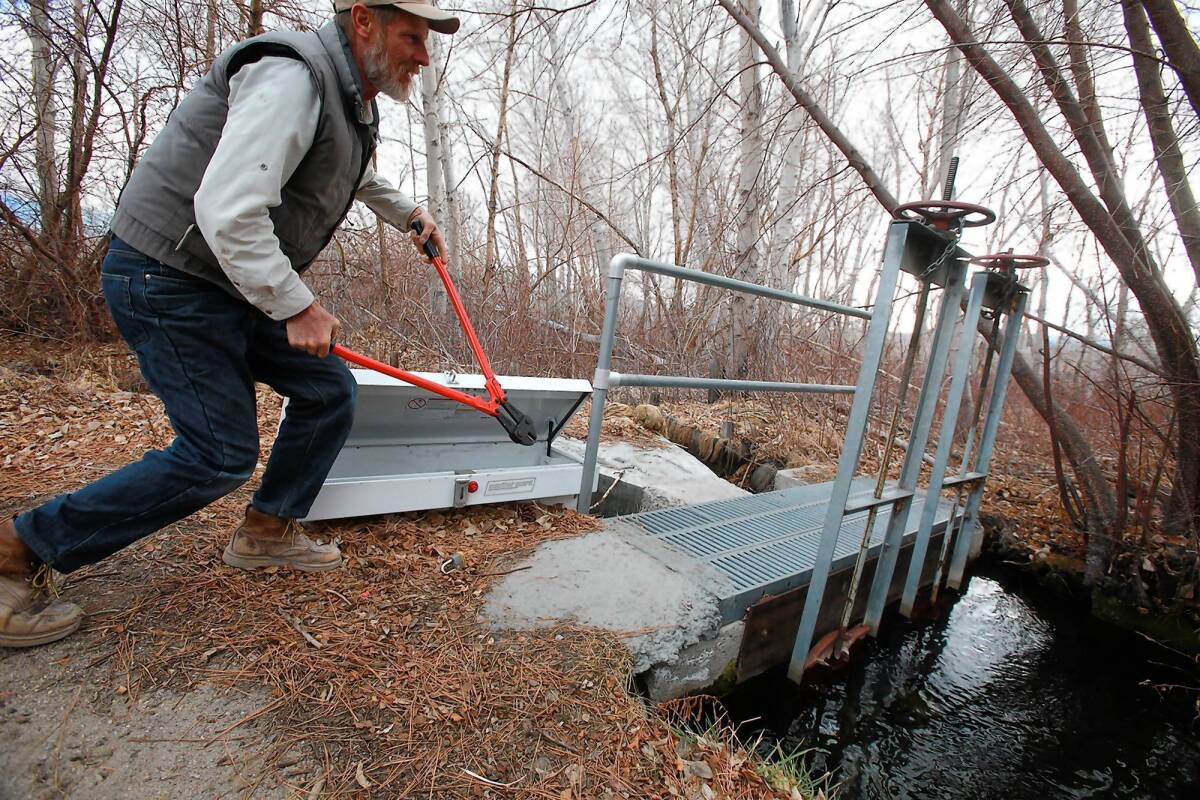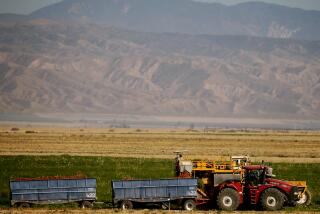DWP seeks truce in water wars as L.A. Aqueduct nears 100

MAMMOTH — For a High Sierra stream whose name evokes mountain serenity, Pine Creek is nobody’s idea of harmony with nature.
On many mornings over the last decade, residents from the eastern Sierra enclave of 40 Acres cut a Los Angeles Department of Water and Power chain so they could open a gate and redirect the creek’s water their way.
On many afternoons, DWP workers closed the gate to send the water cascading into the Los Angeles Aqueduct system and installed another lock and chain.
PHOTOS: Owens Valley water war
Now, in a compromise to end the hostilities, the DWP has left a toolbox beside the gate, along with special instructions: In an emergency, feel free to divert water. And please, use our bolt cutters to cut the chain.
The approaching armistice is astonishing to residents of 40 Acres. But it is not unique these days. DWP is on a campaign to settle three of the most bitter water wars in the Owens Valley before celebrating the 100th anniversary of the Los Angeles Aqueduct in November with a gala at the Dorothy Chandler Pavilion.
If all goes according to plan, legal disputes over water rights with 40 Acres, the Mammoth Community Water District and at Rush Creek, a major tributary to Mono Lake, will be resolved by summer, DWP officials said.
Those settlements would improve the DWP’s image and add luster to Mayor Antonio Villaraigosa’s legacy as he prepares to leave office. “I think they want to be able to say at that centennial celebration ‘We’ve buried some hatchets,’ ” said 40 Acres resident Frank Stewart.
Water wars have defined the 110-mile Owens Valley since the early 1900s, when Los Angeles city agents posed as ranchers and farmers to buy land in the area and obtain the water rights. Their goal was to build the aqueduct system needed to meet the needs of the growing metropolis 200 miles to the south.
Middle ground between the parties has been hard to find since.
The region’s economy and wildlife have struggled in a stunning landscape of snowcapped peaks, cascading streams and sage plains dotted with alfalfa fields and cattle ranches, and flanked by lava flows and dormant volcanoes. At dry Owens Lake, the focus of an agonizingly complex and expensive effort to control dust storms, dust pollution frequently exceeds federal health standards. Some locals have expressed their feelings toward the DWP by urinating in the aqueduct while reciting, “L.A. needs the water.”
These days, many Owens Valley residents are happy about the DWP’s newly conciliatory attitude, even if they wonder why it is coming now instead of much earlier. “The obvious question to ask is, ‘Why couldn’t it have been resolved years ago?’ ” said Geoff Pope, chairman of the board of the 40 Acres Homeowners Water Assn.
The DWP insists publicly that the three settlements have nothing to do with the anniversary festivities. “It’s serendipity,” DWP General Manager Ron Nichols said. “The important thing is to show that the DWP will work with reasonable people to find solutions that work for both sides.”
The standoff at 40 Acres, where the DWP and residents own property and water rights, began in 2001, when the utility constructed the diversion gate controlled with a wheel the size of a dinner plate.
The structure gave DWP control of the water, replacing a wooden diversion gate that locals had installed at a fork in the creek in the mid-1970s. It diverted water into a latticework of ditches, which disperses it through their little patch of cottonwoods, modest homes and pastures.
Under the terms of a proposed settlement, the DWP would supply 40 Acres with an amount of water the community says it needs and permit its residents to snip the chain on the diversion gate wheel in the event of an emergency need for water.
At Mammoth Lakes, about 30 miles north of 40 Acres, no one expected the DWP to give up trying to take over the ski town’s primary source of water, Mammoth Creek.
Yet, less than a year after the utility filed a lawsuit against the small community’s water district, the DWP is weighing a compromise: In return for less than $5 million, Los Angeles would drop its lawsuit and both sides would agree to never challenge each other’s water rights.
The DWP would use the money for water-saving improvements designed to increase the flow of water in the aqueduct.
The district has already run up about $600,000 in legal expenses in the case, said Greg Norby, former manager of the water district, which serves 7,700 year-round residents who are largely working-class employees catering to vacationers who travel 300 miles north from Los Angeles.
The DWP said that it has owned the water since 1905. The water district argues that it is entitled to as much as 2,760 acre-feet of water annually under licenses and a permit granted by the state dating to 1949.
The district also argues that the DWP should not be allowed to claim the water now after allowing the community to become dependent upon it for decades by relying on those licenses and permit.
The parties are scheduled to present the proposed settlement to a judge Feb. 14.
Both sides are optimistic. Norby even praised Nichol’s participation in “marathon negotiation sessions with his cellphone turned off.”
At Rush Creek, a waterway dried up by Los Angeles’ aqueduct system, weary combatants are putting finishing touches on a plan to allow water to flow at normal levels for the first time in more than six decades and sustain a healthy trout population.
It calls for construction of a $12-million adjustable gate in Grant Dam, a World War II era earthen structure 87 feet high and 700 feet long designed to capture tributary water. The goal is to release pulses of water along a seven-mile stretch to mimic annual flood cycles and distribute willow seeds.
Geoffrey McQuilkin, executive director of the nonprofit Mono Lake Committee, believes the DWP-funded project could be operating within four years — roughly two decades after the city was ordered to reduce the amount of tributary water it had been diverting into the aqueduct since 1941.
“DWP has been in a collaborative mood in the Mono Basin, and that is much appreciated,” McQuilkin said.
Back at Pine Creek, bolt cutters are now a symbol of cooperation, 40 Acres resident Stewart mused on a recent weekday.
He smiled mischievously and added: “For a while there, some of us daydreamed about using bulldozers to dig the whole diversion structure up and drop it on Mayor Antonio Villaraigosa’s desk.”
More to Read
Sign up for Essential California
The most important California stories and recommendations in your inbox every morning.
You may occasionally receive promotional content from the Los Angeles Times.











